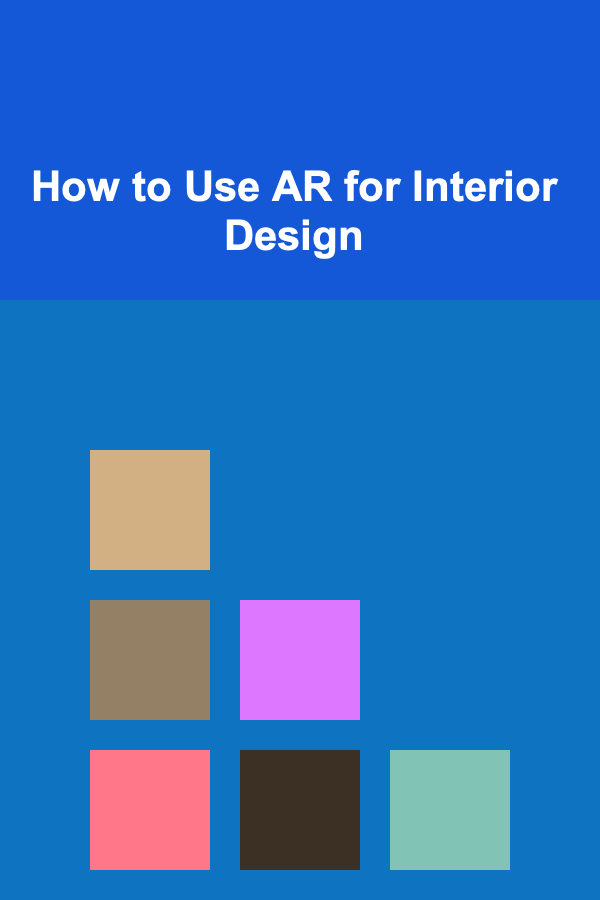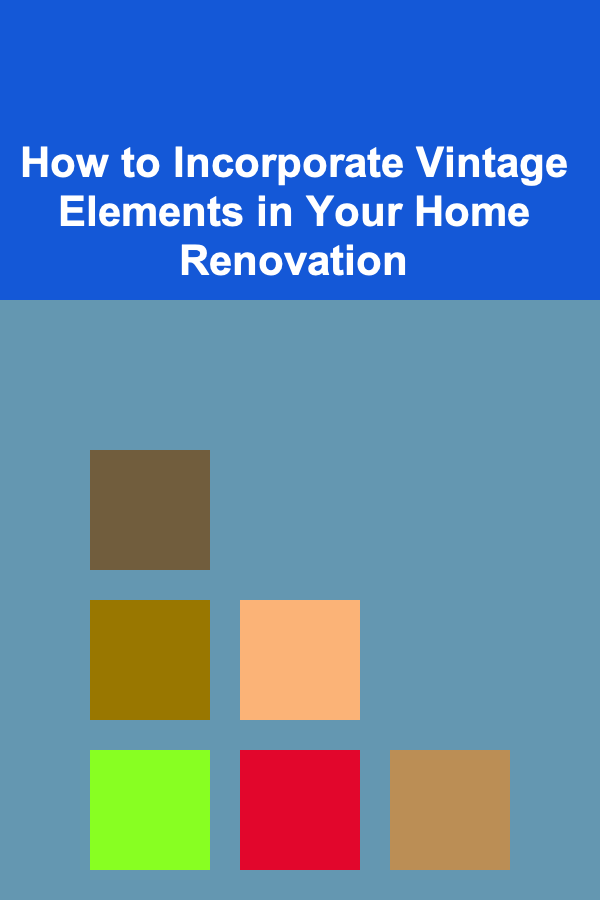
How to Use AR for Interior Design
ebook include PDF & Audio bundle (Micro Guide)
$12.99$6.99
Limited Time Offer! Order within the next:

Augmented Reality (AR) has rapidly emerged as a transformative technology in various industries, and interior design is no exception. This cutting-edge tool allows designers, clients, and homeowners to interact with spaces in innovative ways, enhancing both the design process and user experience. By superimposing digital elements over the real world, AR provides a way to visualize and manipulate interior spaces in real time, offering unprecedented flexibility and creativity.
In this article, we will explore how AR is revolutionizing the field of interior design. From conceptualizing layouts to visualizing furniture, textures, and decor, AR is changing the way we approach design. The article covers the fundamentals of AR, its applications in interior design, its benefits, the challenges it presents, and the future of AR in this field.
Understanding AR in Interior Design
Before diving into how AR is used in interior design, it is important to understand what AR is and how it works. Augmented Reality is a technology that overlays digital information, such as images, sounds, and data, onto the physical world through devices like smartphones, tablets, AR glasses, and headsets. Unlike Virtual Reality (VR), which immerses users in a completely digital environment, AR enhances the real world with digital objects that interact with the user's surroundings.
In the context of interior design, AR can be used to visualize how different design elements---such as furniture, lighting, and wall colors---will look in a real-world space. This is done by using AR applications that display digital content in real time through a screen or lens. By integrating virtual design components with actual physical spaces, AR enables designers and clients to experience and experiment with interior spaces before making any physical changes.
Applications of AR in Interior Design
1. Virtual Furniture and Decor Visualization
One of the most popular uses of AR in interior design is the ability to visualize furniture and decor in a physical space before purchasing. This technology allows users to see how a specific piece of furniture will fit in a room, the color coordination, and how it interacts with other design elements.
For example, apps like IKEA Place allow users to see a wide range of furniture pieces overlaid in their living rooms through their phone or tablet screens. This helps users get a sense of the size, style, and color of items, reducing the risk of purchasing items that do not fit the space or aesthetic.
By virtually placing furniture in a room, clients can instantly experiment with different layouts and combinations, which significantly improves decision-making. This capability not only saves time but also minimizes the need for returns and exchanges due to poor aesthetic or spatial fit.
2. Space Planning and Layout Design
AR can simplify the often complex process of space planning and layout design. Instead of relying on two-dimensional blueprints or imagining how a space will feel, designers and clients can visualize layouts in 3D using AR. This allows for a more realistic understanding of how furniture, walls, lighting, and other elements will fit into a given area.
For example, AR can be used to simulate the arrangement of furniture in a living room, showing how the layout will work in different configurations. This helps identify the best use of space, considering factors like flow, accessibility, and aesthetic appeal.
With AR, clients and designers can experiment with multiple design iterations in real time. This capability removes the guesswork from spatial arrangements and gives an immediate understanding of how a room's layout will look, which is particularly valuable in smaller spaces where every inch counts.
3. Color and Material Selection
Choosing the right color scheme and materials for a space is a critical component of interior design. AR can assist in visualizing different color palettes and materials in real-world environments. Designers can show how a particular shade of paint will look on a wall or how a certain type of fabric will appear on a piece of furniture, all in real time and within the context of the actual space.
With the help of AR, clients can see how various finishes---such as marble countertops, wooden floors, or fabric textures---will interact with the room's lighting and other elements. This eliminates uncertainty and ensures that the chosen materials will work harmoniously within the space before making costly purchases.
4. Lighting Design
Lighting plays a vital role in interior design, affecting the ambiance and functionality of a room. AR can be used to experiment with different lighting effects in a space. Whether adjusting the brightness, color temperature, or positioning of light sources, AR allows users to see how lighting will impact the room's atmosphere.
For instance, lighting design apps using AR can simulate the effects of daylight, artificial lighting, or accent lighting in a room. Clients can adjust the lighting in real-time to determine the best arrangement for creating the desired ambiance, whether it's bright, warm, or moody lighting.
This application of AR is particularly useful when considering lighting for specific activities or spaces, such as a reading nook, kitchen, or workspace, where lighting needs to be functional yet aesthetically pleasing.
5. Virtual Home Tours and Remote Collaboration
AR technology also allows designers and clients to experience virtual tours of their designs or spaces. With this feature, homeowners can view a virtual tour of their home or office, allowing them to see the design's potential from every angle.
For example, AR-powered apps like Magicplan enable users to create floor plans and walk through them virtually. This technology facilitates remote collaboration between designers and clients, as designers can share an immersive AR experience, even when they are in different locations. This not only speeds up the design process but also ensures that clients can provide feedback in real time, without the need for constant meetings or site visits.
6. Customization and Personalization
AR can also enhance the customization and personalization of interior design by enabling users to tailor their spaces to their exact preferences. With AR, clients can visualize bespoke furniture pieces or accessories before making a purchase, ensuring that they align with their tastes and needs.
Some AR tools offer interactive features, such as virtual "swapping" of furniture, wall colors, or art pieces. Users can experiment with design elements, try new looks, and make personalized changes to their interiors in real-time, without the need for physical alterations. This personalized approach helps clients make more informed choices that reflect their individual style.
Benefits of Using AR for Interior Design
1. Increased Accuracy and Reduced Mistakes
AR eliminates the guesswork in interior design, offering a more accurate representation of how a space will look once completed. By visualizing digital design elements in a real-world setting, designers and clients can identify potential issues with layout, scale, and aesthetics before they occur.
This level of precision helps minimize mistakes, such as purchasing furniture that doesn't fit, selecting the wrong colors, or making design choices that don't complement the space. The ability to test various combinations in real-time increases the likelihood of achieving a design that meets expectations and functions effectively.
2. Enhanced Client Engagement and Satisfaction
AR enhances client engagement by allowing them to actively participate in the design process. Clients can view different design options and give immediate feedback, creating a more collaborative relationship with the designer. The interactive nature of AR ensures that clients are involved in every step of the design process, which boosts satisfaction and trust.
This high level of engagement also allows clients to experience their vision for the space before any physical work begins, ensuring that their expectations are met, and resulting in a more positive experience overall.
3. Time and Cost Efficiency
By using AR to visualize designs in advance, the time and cost associated with trial and error are significantly reduced. Traditional interior design involves physical prototyping, purchasing, and returning items based on the final look, which can be both costly and time-consuming. With AR, this process is streamlined, as designs can be tweaked digitally until the perfect solution is found.
AR also reduces the need for multiple revisions or re-designs after physical work begins, saving both time and resources. The ability to experiment with multiple layouts and configurations in a digital format ensures that the final design is closer to the intended outcome.
4. Better Spatial Awareness
AR enhances spatial awareness by allowing users to see how different design elements will fit within a given space. This is especially useful for interior design in smaller or unconventional spaces, where every inch counts. AR allows designers and clients to test different arrangements and placements in real-time, ensuring that the final layout optimizes space and functionality.
Challenges of Using AR in Interior Design
1. Technical Limitations
While AR technology has advanced significantly in recent years, it still faces some technical limitations. The quality of the visualizations and the interaction capabilities of AR applications may vary depending on the hardware used, such as smartphones or AR glasses.
Additionally, AR applications can sometimes have issues with object recognition, spatial mapping, and scaling, which may affect the accuracy of visualizations. Developers need to continually improve these technologies to provide seamless and realistic AR experiences for interior design.
2. Cost of Implementation
Implementing AR in interior design can require significant investment, especially for high-quality AR tools and software. While many consumer-facing AR apps are relatively affordable or free, professional-grade AR solutions for interior designers may involve higher costs. For small businesses or individual designers, this may present a barrier to entry.
Additionally, creating custom AR solutions or integrating AR into existing design processes may require specialized knowledge and expertise, which could incur further expenses.
3. Learning Curve
Although AR is becoming more user-friendly, there is still a learning curve associated with using this technology, especially for those who are not tech-savvy. Designers may need time to familiarize themselves with the software and hardware required to effectively use AR in their design process. Training and ongoing support may be necessary to maximize the potential of AR.
The Future of AR in Interior Design
The future of AR in interior design is incredibly promising, with continuous advancements in technology opening up new possibilities for designers and clients alike. As AR devices become more sophisticated, affordable, and widespread, the adoption of AR in interior design will continue to grow. Future developments may include:
- Improved Realism: Advances in AR graphics and object recognition will make virtual design elements even more lifelike, offering a more immersive and convincing design experience.
- Wearable AR Devices: AR glasses and other wearable devices may replace smartphones and tablets as the primary interface for interior design AR, allowing for a more natural, hands-free design process.
- Enhanced Collaboration: AR will enable real-time, remote collaboration between designers, clients, and contractors, streamlining the entire design process and improving communication.
- AI Integration: The combination of AR and AI could lead to more intelligent design tools, where the system automatically suggests design improvements based on user preferences, space limitations, and current trends.
Conclusion
AR has already started to make a significant impact on interior design, offering designers and clients a more efficient, accurate, and immersive way to plan and visualize spaces. From visualizing furniture to experimenting with layouts and lighting, AR enhances the design process, improves client engagement, and reduces the time and costs associated with traditional design methods.
While there are challenges to overcome, such as technical limitations and implementation costs, the future of AR in interior design is bright. As the technology continues to evolve, it promises to transform the way we design and experience spaces, providing even more opportunities for creativity, customization, and collaboration.

How to Create a Cozy Family Reading Nook
Read More
How to Incorporate Vintage Elements in Your Home Renovation
Read More
How to Set Up a Reward System for Family Contributions
Read More
How to Stage a Home with Contemporary Furniture for Young Buyers
Read More
The Voiceover Vault: Essential Tips and Tricks for Success in the Industry
Read More
How to Use the "Next Action" Principle
Read MoreOther Products

How to Create a Cozy Family Reading Nook
Read More
How to Incorporate Vintage Elements in Your Home Renovation
Read More
How to Set Up a Reward System for Family Contributions
Read More
How to Stage a Home with Contemporary Furniture for Young Buyers
Read More
The Voiceover Vault: Essential Tips and Tricks for Success in the Industry
Read More